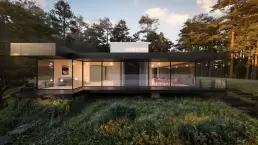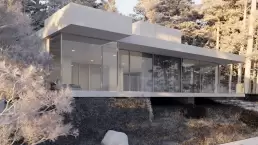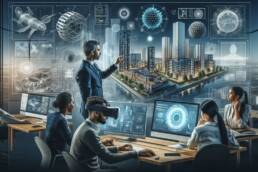In the visually driven market of commercial rendering, mastering various techniques to maximize impact is crucial for success. This article delves into the theoretical foundations, advanced photorealistic rendering techniques, effective 3D architectural visualization strategies, innovations in animation and interactive media, and provides insightful industry case studies. These elements are essential for creating compelling visual narratives that captivate audiences and support commercial objectives.
Key Takeaways
- Understanding the psychological effects of color and lighting can significantly enhance the emotional appeal of commercial renderings.
- Achieving photorealism through advanced texture mapping and materiality is key to producing high-quality visualizations that resonate with viewers.
- Optimizing 3D architectural models for impact involves careful consideration of scale, perspective, and interactive elements to engage the audience.
- Incorporating animation and real-time interactive rendering techniques can create dynamic presentations that foster audience engagement.
- Case studies reveal the importance of client collaboration and adapting to feedback, which can lead to successful projects and influence market trends.
Theoretical Foundations of Commercial Rendering
1. Understanding the Visual Language of Commercial Imagery
In our pursuit of excellence in commercial rendering, we recognize the profound influence of the visual language. High-quality commercial building renderings are essential for marketing and selling commercial real estate, providing visual communication, enhancing understanding, and driving sales success. These renderings serve as a bridge between the conceptual and the tangible, allowing potential clients to envision the final product compellingly and realistically.
To master this visual language, one must appreciate the subtleties of imagery that resonate with viewers. It’s not just about creating a visually appealing scene; it’s about crafting an experience that evokes the right emotions and conveys the intended message. Consider the following points:
- The strategic use of color to convey mood and atmosphere.
- The importance of lighting in highlighting features and creating depth.
- The role of composition in guiding the viewer’s eye and emphasizing key aspects.
By focusing on these elements, we can create renderings that not only captivate but also communicate effectively, ensuring that every visual tells a story that aligns with our clients’ goals.
In the realm of commercial rendering, the psychological impact of these elements cannot be overstated. The right combination of colors and lighting can transform a simple rendering into a powerful tool for engagement. As we delve deeper into the nuances of this craft, we invite you to explore the advanced techniques and strategies that can elevate your commercial projects to new heights.
2. Psychological Impact of Color and Lighting in Renderings
We recognize the profound influence that color and lighting have on the psychological reception of commercial renderings. Color temperature, for instance, shifts throughout the day, affecting the mood and atmosphere of a space. This subtle interplay is not lost on us as we craft renderings that evoke specific emotional responses, essential for commercial building projects where stakeholder decisions are paramount.
The strategic use of lighting and color in renderings can transform the perception of space, creating environments that are not only visually appealing but also emotionally resonant.
By understanding the psychological underpinnings of visual perception, we can manipulate these elements to our advantage. Consider the following aspects of lighting design:
- Ambient lighting: Sets the overall mood of the space.
- Task lighting: Focuses on areas of functionality.
- Accent lighting: Highlights key architectural features.
Each layer contributes to a comprehensive visual narrative that guides the viewer’s experience, ensuring that every rendering we produce is not just a visual representation, but a strategic tool for engagement and decision-making.
3. Balancing Aesthetics and Functionality in Visualization
In our pursuit of excellence in commercial rendering, we recognize the delicate interplay between aesthetics and functionality. Our renderings are crafted to captivate the eye and serve a practical purpose, ensuring that the visual narrative aligns with the intended use of the space or product. This dual focus is essential for creating beautiful and beneficial renderings for our clients.
Visual Comfort and Energy Efficiency are paramount pillars in our lighting designs. We strive to minimize visual discomfort while maximizing energy savings, without compromising on the quality of illumination. Here’s a brief overview of our approach:
- Visual Comfort: Aim for uniform illumination, avoiding harsh shadows or reflections.
- Energy Efficiency: Specify energy-efficient light sources and controls to reduce environmental impact.
Our expertise in balancing these aspects has been recognized by clients who have lauded our ability to bring their visions to life with clarity and precision.
We invite you to explore our portfolio of successful projects and consider partnering with us for your next venture. Our team is adept at navigating the complexities of 3D rendering, transforming your ideas into compelling visual stories. Let us guide you through the process, from initial concept to final rendering, ensuring that every detail is honed to perfection.
Advanced Techniques in Photorealistic Rendering

1. Achieving Realism through Texture Mapping and Materiality
In our pursuit of photorealism in commercial rendering, we recognize the pivotal role of texture mapping and materiality. Texture mapping is not merely a process; it’s an art form that breathes life into 3D models, transforming them from flat, lifeless shapes into vibrant, tactile surfaces. By meticulously crafting texture maps, we can simulate the intricate details of real-world materials, from the roughness of stone to the sheen of polished wood.
The essence of realism in rendering lies in the subtleties of texture and material nuances that evoke sensory experiences.
Our approach involves a blend of technical prowess and creative experimentation. We experiment with various texturing techniques to achieve the desired look and feel, often painting directly onto the texture map to ensure precision and authenticity. The table below illustrates the impact of different texturing techniques on the perception of material quality:
| Technique | Perception of Material Quality |
|---|---|
| Bump Mapping | Enhanced Surface Detail |
| Displacement Mapping | Increased Depth and Realism |
| Specular Mapping | Improved Reflection and Gloss |
By integrating these techniques, we can manipulate how light interacts with surfaces, thereby influencing the viewer’s psychological response. This meticulous attention to detail is what sets apart a good rendering from a truly immersive visual experience. We invite you to explore the transformative power of texture mapping in your next project, ensuring that every rendering tells a compelling story.
2. Incorporating Dynamic Lighting and Reflections
In the realm of commercial rendering, dynamic lighting and reflections are pivotal in creating a sense of realism and depth. We understand that the interplay of light and materials is crucial for conveying the right atmosphere and texture in a visual presentation. By mastering dynamic lighting, we can simulate the nuanced effects of natural and artificial light sources, enhancing the visual storytelling of any commercial space or product.
Dynamic lighting is not just about brightness and shadows; it’s about the subtleties of how light interacts with different surfaces. Reflections add another layer of complexity, as they must be carefully crafted to reflect the environment realistically. We employ advanced techniques such as real-time Bidirectional Reflectance Distribution Function (BRDF) editing and frequency domain normal map filtering to achieve this effect.
Our approach to incorporating dynamic lighting and reflections involves a meticulous process:
- Analyzing the lighting requirements and goals for each project
- Customizing lighting simulations to match the desired mood and effect
- Iterating on the rendering to fine-tune reflections and highlights
We strive to create renderings that not only look stunning but also resonate with the viewer on an emotional level. Crafting photorealistic environments in 3D architectural imagery with tiered rendering options, customizable lighting simulations, and consultations for clients’ informed choices is at the heart of our service.
3. Utilizing Post-Processing for Enhanced Detail and Clarity
In the realm of commercial rendering, post-processing is the pivotal stage where the raw beauty of a rendering is refined into a masterpiece. It’s where we, as visual artists, apply our expertise to enhance detail and clarity, ensuring that every pixel conveys the intended message with precision. Post-processing techniques are not just about applying filters or adjustments; they are about breathing life into images, transforming them into visual narratives that captivate and engage the audience.
Our approach to post-processing involves a meticulous process of sharpening, color correction, and artifact removal. For instance, we utilize advanced methods such as high-frequency transfer to sharpen out-of-focus images, as detailed in the EuroGraphics 2013 paper on the subject. This technique allows us to enhance the sharpness of an image by transferring details from a similar sharp image, providing a significant improvement in the visual quality of macro, sports, and portrait photography.
By exploiting interpixel coherency relations and designing nonadaptive illumination patterns, we minimize measurement noise and maximize the fidelity of our renderings.
Furthermore, we address image degradation through restoration and depth estimation, refining the final image to a degree of clarity that stands out in the competitive market. Our commitment to excellence is echoed by our clients, who have consistently rated our visualization expertise highly, as seen in numerous five-star reviews.
To ensure that our clients receive the best possible outcome, we follow a structured workflow:
- Sharpening and clarity enhancement
- Color correction and grading
- Artifact removal and image restoration
- Dynamic range optimization
- Final quality checks and client approval
Strategies for Effective 3D Architectural Visualization

1. Optimizing Architectural Models for Maximum Impact
In our pursuit of excellence in commercial rendering, we recognize the pivotal role of optimizing architectural models to achieve maximum visual impact. The strategic refinement of models is essential, ensuring that every detail contributes to a cohesive and compelling visual narrative. By meticulously adjusting textures, lighting, and scale, we transform rudimentary structures into captivating representations of architectural intent.
Cost-effectiveness is a significant advantage of digital model optimization. Design revisions, which are often necessary, become more efficient and less resource-intensive when handled within a digital framework. This approach not only saves time but also reduces the financial burden associated with physical model adjustments or construction rework.
Our commitment to optimizing architectural models extends beyond mere aesthetics; it encompasses a holistic approach to visualization that marries form with function, delivering renderings that resonate with clients and stakeholders alike.
To illustrate the multifaceted benefits of model optimization, consider the following points:
- Enhanced pre-construction sales through lifelike imagery and animations
- Improved design communication, facilitating a shared vision between architects and clients
- Accelerated design process by enabling real-time visual feedback
2. Navigating the Complexities of Scale and Perspective
In the realm of 3D architectural visualization, mastering the intricacies of scale and perspective is paramount to creating impactful renderings that resonate with viewers. We understand that the perception of size and depth within a virtual space can make or break the effectiveness of a presentation. By employing advanced techniques, we ensure that our renderings accurately reflect the intended design, conveying both the grandeur of large-scale projects and the intimacy of smaller spaces.
Scale is not just about the size of objects about each other, but also about how that size translates to the viewer’s experience. A well-executed architectural aerial rendering, for example, can provide a comprehensive view of a project, placing it within the larger context of its environment. This approach is essential for clients to visualize the complete guide to their project’s potential impact.
To illustrate the importance of perspective, consider the following points:
- Perspective determines how we perceive the relationship between objects.
- It influences the emotional response to a space.
- An accurate perspective helps ensure design intentions are communicated.
By meticulously adjusting the vantage points and angles in our renderings, we craft visuals that not only depict spaces with precision but also evoke the desired atmosphere and narrative.
3. Interactive Elements and Virtual Reality Integration
In the realm of commercial rendering, we are witnessing a transformative era where interactive elements and virtual reality (VR) integration are not just futuristic concepts but essential tools that elevate the user experience to unprecedented levels. Virtual tours and 360-degree views have revolutionized the way potential clients interact with spaces, allowing them to immerse themselves in environments that are yet to be constructed.
By integrating VR, we empower clients to make informed decisions by experiencing a property’s layout and features as if they were physically present. This immersive approach has proven to be a game-changer in the real estate market.
The statistics speak for themselves. Research indicates that listings with virtual tours are significantly more likely to sell, and do so more swiftly, than those without. Here’s a snapshot of the impact:
- Listings with virtual tours are 87% more likely to sell
- Properties with virtual tours sell 10% faster
As we continue to push the boundaries of what’s possible in commercial rendering, it’s clear that the integration of interactive and VR elements is not just a trend but a cornerstone of modern visualization strategies. We invite you to explore the potential of these technologies and consider how they can be harnessed to maximize the visual impact of your next project.
Innovations in Animation and Interactive Media
1. The Role of Animation in Commercial Presentations
In the realm of commercial rendering, animation has emerged as a pivotal tool for storytelling and engagement. We harness the dynamic nature of animation to convey complex ideas and narratives that captivate potential clients, aiding them in their decision-making process. By providing detailed visuals of various materials in a property, showcasing day and night renders, and creating 3D landscape models, presentations become more immersive and impactful.
This level of detail creates a lasting impression on clients, thereby boosting their confidence and trust in the professionals.
To effectively utilize animation in commercial presentations, consider the following guidelines:
- Quality Over Quantity: High-quality visuals and clear audio are essential for making a professional impression.
- Tell a Story: Use narrative elements to make the video more engaging.
- Focus on Benefits: Highlight the unique features and benefits of the property, emphasizing what sets it apart from competitors.
As we venture into 2024, the significance of short animated videos continues to grow, with businesses across industries recognizing their potential to drive engagement. Animation not only enhances the visual appeal but also simplifies the communication of complex subjects, making it an indispensable element in the arsenal of commercial rendering techniques.
2. Interactive Rendering: Engaging Audiences with Real-time Visualization
In our pursuit of excellence in commercial rendering, we’ve embraced interactive rendering as a pivotal tool for engaging audiences. This real-time visualization technology allows clients to explore and interact with 3D models in a dynamic and immersive environment. The immediacy of this interaction enhances the design process and client engagement, making it a cornerstone of modern visualization strategies.
Interactive rendering transforms the client experience by providing a hands-on approach to design review and decision-making. Here’s a brief overview of the benefits:
- Real-time feedback and adjustments
- Enhanced understanding of spatial relationships
- Increased emotional connection to the project
By integrating interactive elements into our renderings, we not only showcase the aesthetic appeal but also the functionality of a space.
At Render Atelier, we specialize in 3D rendering for architectural projects, offering photorealistic representations that are further enriched by 3D visualization technology. Our commitment to innovation ensures that every project we undertake is not just seen, but experienced. To discover more about how we can bring your project to life with interactive rendering, visit our website or contact us directly.
3. The Future of Commercial Rendering: AI and Machine Learning
As we peer into the horizon of commercial rendering, the integration of Artificial Intelligence (AI) and Machine Learning (ML) heralds a transformative era. These technologies are not just buzzwords; they are reshaping the landscape of visualization, offering unprecedented levels of efficiency and creativity. AI-driven algorithms are now capable of generating photorealistic images in a fraction of the time it once took, revolutionizing the industry’s productivity.
The application of AI in rendering extends beyond mere speed. It encompasses the enhancement of image quality through advanced denoising techniques, the automation of labor-intensive tasks such as texture mapping, and the intelligent interpretation of design data to produce more accurate and lifelike visualizations. The synergy between AI and human creativity is creating a new paradigm where the boundaries of what can be visualized are constantly being expanded.
Our commitment to harnessing the latest AI technology trends ensures that our clients remain at the forefront of innovation. We are dedicated to exploring the full potential of AI and ML to deliver renderings that not only captivate but also drive business success.
In the realm of real estate, for instance, AI-enhanced cloud rendering services have become a game-changer. The ability to rapidly produce high-quality visuals is crucial in a market where the visual impact can make or break a sale. Here’s a glimpse at how AI is elevating the real estate visualization experience:
- Faster Rendering Times: Drastically reduced through cloud-based AI computation.
- Enhanced Realism: AI algorithms improve textures, lighting, and materiality.
- Interactive Visualizations: AI facilitates the creation of immersive virtual tours.
- Client Engagement: Real-time AI rendering allows for immediate client feedback and iterations.
As we continue to explore and integrate these advancements, we invite our clients and partners to join us in shaping the future of commercial rendering. Together, we can unlock new possibilities and ensure that our visual narratives are not only seen but felt and experienced in ways previously unimaginable.
Case Studies and Industry Insights
1. Analyzing Successful Commercial Rendering Projects
In our quest to understand the transformative power of commercial rendering, we meticulously examine successful projects that have set benchmarks in the industry. One such project that stands out is the 3D Rendering & Green Home Tech: Architech’s Guide to Sustainability. The success of this project underscores the efficacy of 3D rendering in overcoming the challenges of limited space and light in urban environments.
Our analysis reveals that the key to impactful commercial renderings lies in the meticulous integration of design and technology. By scrutinizing various case studies, we’ve identified several factors that contribute to a rendering’s success:
- The strategic use of dynamic lighting to evoke emotions
- The application of high-quality textures for enhanced realism
- The incorporation of interactive elements to engage viewers
- The careful consideration of viewer perspective to ensure clarity
We believe that the essence of a successful rendering is not just in its aesthetic appeal, but also in its ability to communicate the intended message effectively.
As we delve deeper into these projects, we invite our readers to explore the nuances of commercial rendering and to consider how these techniques can be applied to their own work for maximum visual impact. For those eager to elevate their rendering skills, we offer comprehensive services tailored to a wide array of needs, from residential to highrise, and from landscaping to product visualization. Visit our services page to discover how we can assist you in bringing your visions to life.
2. Client Collaboration and Feedback in the Creative Process
In our pursuit of excellence in commercial rendering, we at CG Viz Studio recognize the pivotal role of client collaboration and feedback. Our iterative process ensures that each rendering not only meets but exceeds client expectations, fostering a relationship of trust and satisfaction. This collaborative approach is a cornerstone of our service, as it allows for a shared vision to be meticulously refined and realized.
Through open communication channels, we invite our clients to be active participants in the creative journey. By incorporating their insights and preferences, we navigate the nuances of their unique requirements. Our commitment to this partnership is reflected in the positive outcomes and testimonials from those we’ve served:
- Improved communication with clients, making complex plans accessible and understandable.
- Easier implementation of changes, saving time and money.
- Enhanced user experience through detailed and immersive presentations.
Our dedication to client collaboration is not just about achieving high-quality renderings; it’s about ensuring that the final product resonates with the audience and serves its intended commercial purpose effectively.
We encourage prospective clients to explore the benefits of our high-quality renderings, which lead to client satisfaction, cost savings, and improved communication in the architecture industry. For more information on how we can assist in bringing your commercial rendering projects to life, please visit our website or contact us directly.
3. Evaluating the Impact of Rendering Techniques on Market Trends
In our exploration of commercial rendering, we’ve observed a significant shift in market trends, particularly within the real estate sector. The advent of 3D real estate rendering services has not only enhanced marketing strategies but also played a pivotal role in attracting buyers, thereby increasing sales and exposure for realtors. These services, which include the visualization of interiors and exteriors, have become indispensable tools for professionals seeking to stand out in a crowded marketplace.
The integration of advanced rendering techniques has led to a transformation in the way properties are presented, with a marked improvement in both time and cost efficiency.
The table below highlights the benefits of incorporating rendering services into real estate marketing:
| Benefit | Description |
|---|---|
| Enhanced Property Presentations | More engaging visuals lead to increased client interest. |
| Attraction of More Buyers | High-quality renderings serve as a powerful marketing tool. |
| Improved Time and Cost Efficiency | Faster production of visuals with reduced costs. |
As we continue to monitor these developments, it’s clear that rendering techniques are not just changing the face of commercial visualization but are also shaping the future of how products and properties are marketed and sold.
Get your project estimated within 60 minutes - simply send us your project brief!
Conclusion
In conclusion, the realm of commercial rendering is a dynamic and ever-evolving field that demands a keen eye for detail and a deep understanding of visual storytelling. Techniques discussed throughout this article, from leveraging the latest software to understanding the psychological impact of lighting and textures, are pivotal in maximizing the visual impact of renderings. As evidenced by the testimonials for CG Viz Studio, the ability to produce high-quality, photorealistic images that resonate with clients is invaluable. The integration of advanced rendering services into real estate marketing and the design of modern entertainment spaces exemplifies the transformative power of these visualizations. Ultimately, the goal is to create renderings that not only captivate but also communicate the essence of a project, thereby enhancing its marketability and appeal. The future of commercial rendering is bright, with technological advancements promising even more sophisticated and immersive visual experiences.
Frequently Asked Questions
Commercial rendering involves creating two-dimensional images or animations that showcase the design and features of a commercial product, space, or concept using computer graphics. It is used extensively in marketing, advertising, and visualization of projects before they are built.
Color and lighting play a critical role in commercial renderings as they can influence mood, highlight key features, and create a sense of realism. Proper use of these elements can enhance the psychological impact and visual appeal of the rendered images.
Texture mapping is essential in photorealistic rendering as it adds detailed surface properties to 3D models, such as color, bumpiness, and reflectivity, which contribute to the overall realism of the rendered image.
Yes, 3D architectural visualization can significantly impact real estate marketing by providing potential buyers with immersive and detailed views of properties, aiding in pre-construction sales, and enhancing online listings to attract more interest.
Animation adds dynamic and engaging elements to commercial presentations, helping to illustrate processes, demonstrate product features, and create memorable experiences that can captivate and inform the audience.
AI is revolutionizing commercial rendering by automating complex tasks, enhancing image quality through machine learning algorithms, and enabling more personalized and interactive experiences through real-time rendering and virtual reality.



